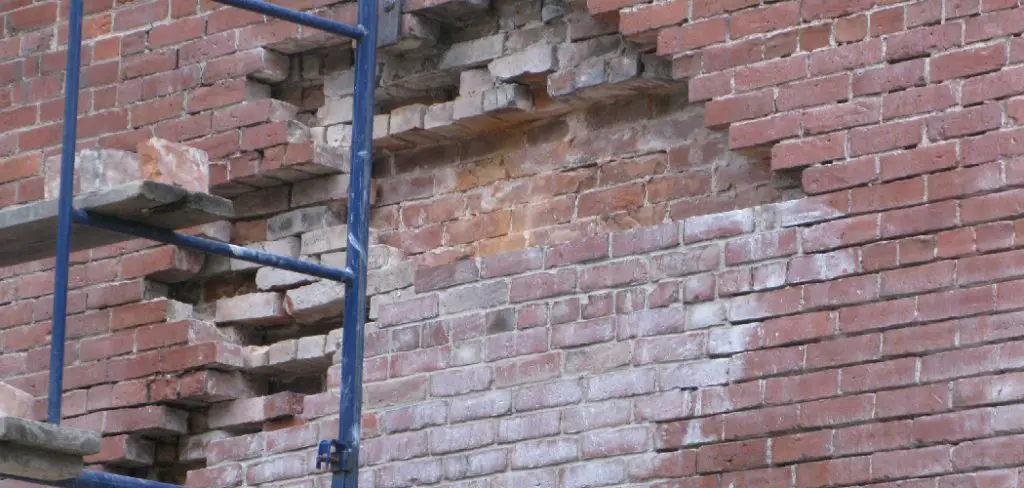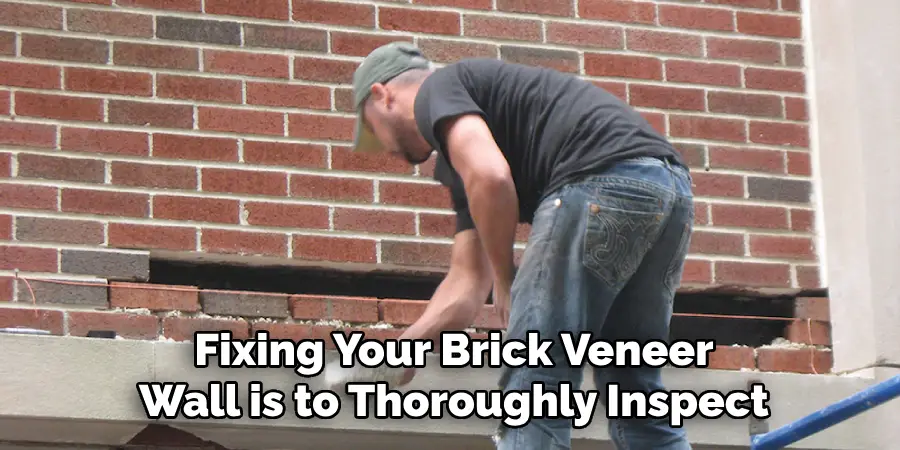Welcome to our ultimate guide on how to fix a brick veneer wall! Whether you’re a seasoned DIY enthusiast or a novice homeowner looking to tackle a new project, this blog post is for you. We understand the frustrations that come with a damaged brick veneer wall – from unsightly cracks and loose bricks to water leakage and energy loss.

But fear not! Throughout this comprehensive guide on how to fix brick veneer wall, we will walk you step-by-step through the process of fixing your brick veneer wall, providing you with valuable tips, tricks, and expert advice along the way. So roll up your sleeves, grab your tools, and get ready to transform your wall into a beautiful, sturdy, and functional feature of your home. Let’s dive in!
What is a Brick Veneer Wall?
Before we dive into the process of fixing a brick veneer wall, it’s essential to understand what it is. A brick veneer wall is essentially a non-load-bearing structure made of brick placed against an exterior wall of a building. It serves as a decorative and weather-resistant feature, providing insulation and protection to the underlying structure. Unlike a solid brick wall, a brick veneer wall is not a structural component of the building and can be easily damaged if not properly maintained.
Needed Tools and Materials
Before starting any repair work on your brick veneer wall, make sure you have all the necessary tools and materials. Here’s a list of items you will need:
- Protective Gear: Safety Goggles, Dust Mask, Gloves
- Hammer and Chisel
- Brick Jointer or Trowel
- Mortar Mix
- Masonry Brush
- Wire Brush
- Water
- Caulking Gun
- Silicone Caulk
- Sealant or Waterproofing Solution
11 Step-by-step Guides How to Fix Brick Veneer Wall
Step 1: Inspect the Wall

The first step in fixing your brick veneer wall is to thoroughly inspect it. Look for any signs of damage, such as cracks, loose or missing bricks, or water leakage. Take note of the areas that need repair and make a list of the tools and materials required. If the damage is extensive or beyond your repair abilities, it’s best to consult a professional.
Step 2: Prepare the Area
Before starting any repair work, prepare the area by removing any loose debris and sweeping away dust and dirt. This will ensure that your workspace is clean and safe. You may also want to cover nearby plants and furniture to protect them from falling debris. But don’t worry, as this is a relatively clean and non-intrusive repair project. It won’t create much mess.
Step 3: Remove Damaged Bricks
With your protective gear on, use a hammer and chisel to gently remove any damaged or loose bricks. Be careful not to damage the surrounding bricks as you remove them. If the brick is still intact but has a small crack, you can skip this step and move on to step five. You can also use a wire brush to clean any debris or loose mortar from the area.
Step 4: Prepare Mortar Mix
Mix your mortar according to the manufacturer’s instructions. The consistency should be similar to that of toothpaste. You can add water if needed, but be careful not to make it too watery, as this will weaken the mixture. But if the mortar mix is too thick, it will be difficult to work with. It may take a few tries to get the right consistency.
Step 5: Apply Mortar
Using a trowel or brick jointer, apply a layer of mortar to the back of each replacement brick. This will help it stick better to the wall. Then, place the new brick in the designated area and press firmly. Make sure it is properly aligned with the surrounding bricks. Otherwise, it will stand out, and the wall’s structural integrity may be compromised.
Step 6: Fill in the Joints

Using your trowel or brick jointer, fill in the joints around the new brick with mortar. Make sure to smooth out any excess mortar on the surface of the bricks for a clean finish. You can also use a masonry brush to create a textured look if desired. It’s essential to work quickly, as mortar dries fast. But don’t worry if you make a mistake; you can always remove and redo it.
Step 7: Allow Mortar to Dry
Let the mortar dry for at least 24 hours before moving on to the next step. This will ensure that it is properly set and will not crack or crumble when exposed to external elements. You can cover the area with a plastic sheet or tarp to protect it from rain or direct sunlight while drying. Although mortar dries quickly, it can take a few days to fully cure.
Step 8: Seal the Wall
If your brick veneer wall is exposed to external elements, such as rain or snow, it’s essential to seal it. This will prevent water from penetrating and damaging the bricks and mortar. You can use a waterproofing solution or silicone caulk to seal the joints between the bricks. Make sure to follow the manufacturer’s instructions for best results.
Step 9: Inspect Again
After sealing the wall, inspect it once again to ensure there are no missed cracks or areas that need repair. If you find any, repeat steps three to eight until your brick veneer wall is restored to its original state. However, if the damage is extensive or beyond your repair abilities, it’s best to consult a professional.
Step 10: Clean and Maintain
Once your brick veneer wall is fully repaired, it’s essential to clean and maintain it regularly. This will help prevent future damage and keep your wall looking beautiful for years to come. Use a mild detergent and water to clean the bricks and mortar, being careful not to use harsh chemicals that can cause damage.
Step 11: Enjoy Your Restored Wall
Congratulations! You’ve successfully fixed your brick veneer wall. Now you can sit back and enjoy the fruits of your labor. But don’t forget to regularly inspect and maintain your wall to ensure its longevity. With proper care, your brick veneer wall will continue to be a beautiful and functional feature of your home for many years.
So go ahead on how to fix brick veneer wall and show off your newly restored wall to your friends and family! Remember, a well-maintained brick veneer wall can provide a durable and aesthetically pleasing addition to any building.

So keep these tips in mind to ensure that your brick veneer wall remains in top condition for years to come. With the right tools, materials, and knowledge, fixing a brick veneer wall can be an easy and satisfying DIY project. But always remember to prioritize safety and seek professional help if needed. Happy repairing!
Do You Need to Get Professional Support?
Repairing a brick veneer wall can be a straightforward and manageable task if the damage is minor. However, if the damage is extensive or you don’t have the necessary skills and tools, it’s best to seek professional help.
A masonry contractor or builder will have the expertise and experience to handle any level of damage and ensure that your brick veneer wall is repaired correctly. They can also provide advice on how to maintain and prevent future damage, ultimately saving you time and money in the long run.
It’s always better to be safe than sorry when it comes to home repairs, so don’t hesitate to seek professional support if needed. So go ahead on how to fix the brick veneer wall but remember not to take on more than you can handle. It’s always better to prioritize safety and seek help when needed.
Frequently Asked Questions
Q1: How Long Does It Take for the Mortar to Dry?
A1: Mortar typically takes about 24 hours to dry, but it can take a few days to fully cure. It’s essential to wait at least 24 hours before applying any pressure or exposing it to external elements to avoid compromising the repair.
Q2: Can I Use Regular Mortar for Brick Veneer Wall Repair?
A2: No, it’s best to use a mortar specifically designed for brick veneer wall repairs. These mortars have a higher adhesive strength and flexibility, making them more suitable for this type of repair. Using regular mortar may result in a weaker bond, leading to future damage and repairs.
Q3: How Often Should I Inspect and Maintain My Brick Veneer Wall?

A3: It’s recommended to inspect and maintain your brick veneer wall at least twice a year, especially if it is exposed to external elements. Regular inspections can help identify any potential issues early on and prevent them from becoming more extensive and costly repairs in the future. So make sure to schedule regular maintenance to keep your brick veneer wall in top condition.
Conclusion
In conclusion on how to fix brick veneer wall, repairing a brick veneer wall may seem daunting at first, but with the right tools and knowledge, it is a manageable project that can save you time and money in the long run. Whether it’s due to natural wear and tear or structural damage, following these steps will help you successfully fix your brick veneer wall and restore its beauty.
Remember to carefully inspect the area before starting any repairs, use proper safety precautions, and seek professional help if needed. With patience and determination, you can achieve a strong and durable brick veneer wall that will stand the test of time.
Don’t let those cracks and chips bring down the appearance of your home any longer; take action now and give your wall the TLC it deserves.
So go ahead and put on your handyman (or woman) hat, gather your materials, and get started on fixing that brick veneer wall today! Your efforts will not only improve the look of your home but also increase its value. Trust me, you won’t regret it. Now get out there and become a brick veneer repair expert!
